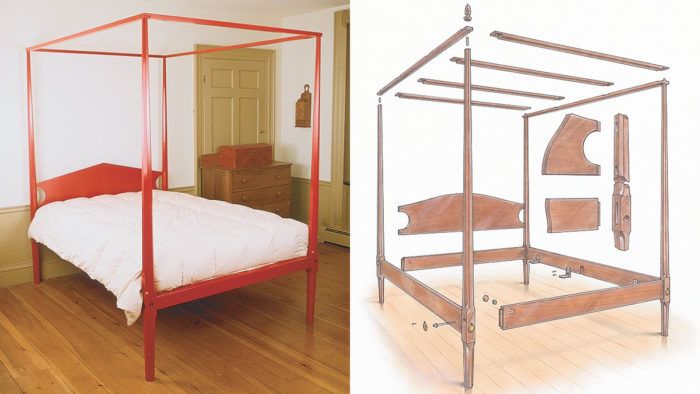The Pencil-Post Bed
Build this classic design with the help of templates and a jig for machining tapered octagons
Synopsis: Christian H. Becksvoort’s pencil-post harks back older times. Becksvoort starts by discussing the origin of the style and then explains how he uses 6-in.-long bed bolts that extend through the posts and into nuts that are trapped within the side rails and the head and foot rails. This type of bed must be made to break down completely, and he explains how to do so and how to taper the 80 in.-tall posts. He uses a jig to bevel the upper portion of the post and explains how he makes and assembles the rails, mortises, headboard, and tester. Side information covers headboard templates and how to modify the overall design.
The pencil-post bed is a classic form that has been in use for centuries, The high posts were originally designed to hold a canopy frame, or tester (pronounced teester), as shown in the photo at right. Before central heating, a canopy was standard equipment and was often accompanied by thick, quilted curtains on all four sides. Drawing the curtains at night created a room within a room designed to conserve warmth and provide privacy. In warm weather, the heavy curtains were replaced by fine lace netting, which offered protection against insects. Today, the testers are covered with either net or lace canopies or left bare, a decorative reminder of earlier times. I usually turn finials for the tops of the posts so the customer has the option of removing the tester entirely and capping the posts with the decorative turnings.
Traditionally, bedding was supported by a rope mattress woven between the bed rails. Early on, the rope also held the bed parts together, but around 1750, builders switched to bed bolts, which could hold the bedstead securely together even when the rope mattress started to sag. The 6-in.-long bed bolts I use extend through the posts and thread into nuts that are trapped within the side rails and the head and foot rails. On conventional, low-post beds, the headboard and footboard are usually glued up and knock-down hardware is used for assembling the side rails. However, it would be difficult, if not impossible, to move an assembled headboard with tall pencil posts upstairs, through doors and around tight comers. Therefore, a pencil-post bed must be made to knock down completely into individual members: four posts, two side rails, a head rail and foot rail, a headboard and a six-piece canopy frame and/or four finials. Besides the eight bed bolts that secure the rails, the bed is held together by the mortises and tenons where the rails and headboard join the posts, and the lap joints on the tester.
Before building this or any bed, check and recheck the actual box-spring dimensions, because they are anything but standard; few people today would want a bed that can accept only a woven rope mattress. I build pencil posts only in full- or queen-size, purely for reasons of proportion. The single-size seems too narrow and tall, while the king-size begins to resemble a cube.
Pencil posts
The evolution of tall bedposts has been from massive square posts to thinner and tapered posts, then to even more delicate, eight-sided tapers, the shape we now associate with pencilpost beds (though most pencils today are six-sided). In addition, I prefer to taper both the upper portion of the post and the shorter, lower portion below the rails. I used to bevel the corners of the tapers with a handplane or spokeshave to create an octagon.
From Fine Woodworking #76
For the full article, download the PDF below:
Fine Woodworking Recommended Products

Drafting Tools

Circle Guide

Drafting Tools























Log in or create an account to post a comment.
Sign up Log in